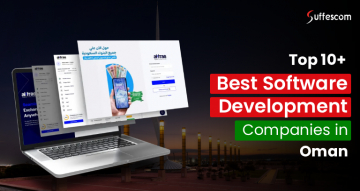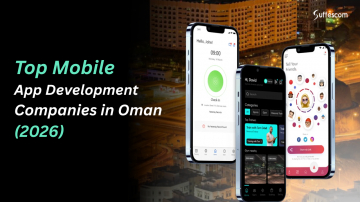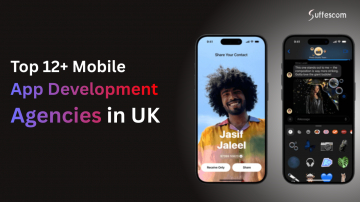AI Medical Diagnosis App Development Cost : 2025 Guide
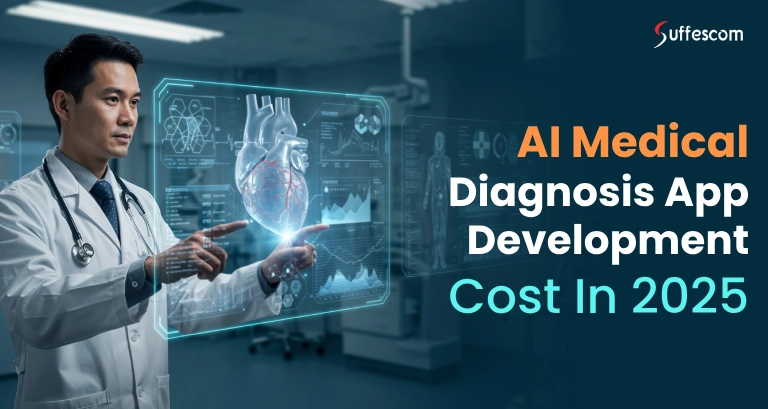
The Growing Importance of AI in Medical Diagnosis
Artificial Intelligence isn't transforming the future of healthcare. It is already integrated the way doctors diagnose, detect, and treat diseases today. According to Precedence Research, the worldwide AI in healthcare market is projected to grow to $36.96 billion by 2025, expanding at a CAGR of 36.83% from 2025 to 2034. Much of this comes from diagnostic AI technologies, which are assisting physicians in examining symptoms. It interprets medical images and even forecasts diseases. Sometimes it improves and resolves more quickly than human professionals.
AI-based diagnosis apps play a crucial role in low-resource environments with limited medical staff. Today's sophisticated platforms can alert users to potential cancer on radiology reports, screen for diabetic retinopathy, evaluate heart health, and even identify uncommon conditions using genetic or lab information. And through integration with EHRs and cloud systems, turnaround time for diagnoses keeps getting shorter, enabling patients and providers alike.
Why Understanding Development Costs Matters
While all this technology is thrilling, there's a costly and complicated bill to create an AI-based medical diagnosis app. By 2025, development expenses will be influenced by increasing demands for data protection, real-time calculation, ethics-based algorithms, and legislative conformity with HIPAA, GDPR, and MDR. These apps need to be intelligent yet safe, approved, and compatible with hospital hardware.
And that’s where the real challenges in budgeting AI medical apps come into play. It’s not about hiring developers or considering a symptom checker. In 2025, the critical factors that boost development costs include stricter privacy laws, real-time decision-making needs, and growing expectations for ethical, bias-free AI. While making one wrong decision, you could blow your budget before even hitting clinical trials. That’s why smart planning is the only survival.
Who Should Read This Guide?
Whether you're building, investing in, or scaling an AI medical tool, this guide breaks down what it takes in 2025.
- Startups are about to debut their very first AI healthtech product
- Healthcare professionals are going digital with their diagnostic processes
- Investors eyeing up prospects for AI healthcare innovation
- Product managers driving AI initiatives within hospitals or medtech firms
While making a plan to develop or fund an AI medical diagnosis app in 2025. It will help you predict the cost, avoid pitfalls, and align your product vision with regulatory and market realities.
Key Components of an AI Medical Diagnosis App
While building an AI-powered medical diagnosis app, give more emphasis on creating a clinically relevant and technically advanced healthcare tool. It understands all the core components that shape both functionality and cost.
Core Features of AI Medical Diagnosis Apps
At the centre of each diagnosis app is a collection of smart features intended to support both patients and clinicians. Most typical core capabilities are:
Symptom Checker: Enables users to enter symptoms and receive an initial diagnosis. It is totally based on decision-tree logic or machine learning models trained from past clinical data.
Medical Image Analysis: For pathology- or radiology-based apps, computer vision may review MRIs, X-rays, CT scans, or histology images to identify abnormalities with good accuracy.
Predictive Analytics: Such modules analyze historical patient data and trends to predict possible health threats or disease progression that is useful in chronic disease management.
EHR Integration: Easy integration with Electronic Health Records so that the app may retrieve real-time patient information and send diagnostic results straight into clinical flows.
Add-ons introduce complexity layers. For example, EHR integration needs compatibility with data exchange standards such as HL7 or FHIR, whereas real-time image analysis helps in GPU-accelerated computing.
AI Technologies Involved : In the background, a combination of advanced AI technologies drives these features. The most prevalent ones are:
Machine Learning: ML models are trained on datasets that analyze patterns and classify medical data. Considering classification models to find skin lesions or arrhythmia detection in ECG reports.
Natural Language Processing (NLP): Allows the app to parse and process free-text inputs. For example, a patient describes the symptoms through the input clinical notes or unstructured health records.
Computer Vision: A specialized form of AI that analyzes visual information from medical imaging scans through the use of convolutional neural networks CNNs.
Deep Learning: It uses multiple layers of neural networks to decode intricate patterns with minimal human guidance. Applied in high-dimensional data situations such as genomics or imaging.
Every AI stack has unique infrastructure and training demands, which have a direct impact on both cost and development time.
Regulatory & Compliance Requirements
You can't build a diagnosis app without considering regulations they're not negotiable, and they greatly affect cost and development time:
HIPAA (U.S.): The app processes patient health information in the U.S. and must comply with HIPAA's stringent privacy and security regulations. It involves adopting encrypted data storage that runs regular security audits to ascertain continuous compliance.
GDPR (EU): Apps conflicting in the European markets need to comply with GDPR guidelines. It includes explicit consent handling, such as data minimization.
FDA or CE Mark Approval: If your app is a medical device (which some AI diagnosis apps are), you'll be required to get regulatory approval in the U.S. (FDA) or the EU (CE marking), involving clinical trials, validation studies, and documentation.
Each compliance layer also incurs extra legal, technical, and testing costs upfront. However, not doing any of them at all could result in a fine, market removal, or worse, ultimately leading to user distrust.
Major Factors Affecting Development Cost in 2025

AI healthcare apps are not cheap to build. You’re not just developing something that looks good on a phone. Instead, you are creating a medical-grade tool that people might actually rely on for life-changing decisions.
Before delving into development, it is essential to understand what drives the cost. It’s not only about coding or design. There’s a mixture of technology choices, team expertise, compliance work, and data challenges. Each factor includes its own weight in the budget. So let’s break it down in simple language.
- Complexity of AI Algorithms and Data Training
Here’s the deal—your app’s “intelligence” depends on how much data it learns from. But not just any data. We’re talking about real, verified medical records, symptoms, images, and clinical notes. And those are hard to get.
Even if you do get your hands on clean data, training a reliable model takes time. To achieve high accuracy, you will undergo rounds of testing and fine-tuning. The smarter the AI, the longer and higher the budget of the training process.
- Talent and Expertise Costs
You can’t build a solid healthcare app without the right people. And not just developers. You’ll need AI engineers, sure. But you’ll also need data scientists, medical advisors, testers, and probably someone who understands health regulations inside out.
These roles aren’t easy to fill, especially in 2025. Medtech is booming, and experienced professionals know their value. If you're serious about building something that works (and doesn’t get you into legal trouble), be ready to invest in the right team.
- Integration with Existing Medical Systems
Let’s say you build the app. Great. But can it actually “talk” to the hospital’s systems?
Most healthcare providers use platforms like EHRs (Electronic Health Records), and those aren’t plug-and-play. They come with their own formats, standards, and, well, quirks. If your app can’t connect to them smoothly, it won’t be used simply as that.
So, developers need to build bridges (techy folks call these integrations). And yes, that takes time, effort, and extra budget.
- Platform and Technology Stack Choices
Now let’s talk about the technology that needs to be used . Are you building for mobile, web, or both? Going with Google Cloud, AWS, or Azure? Using TensorFlow or PyTorch for your AI models?
These decisions sound so technical, impact cost and flexibility. Some stacks are faster to develop but harder to scale. Others may cost more upfront, but they save you headaches down the road. Pick a setup that your team is comfortable with. It’ll save you more than you think.
- Security and Privacy Measures
In healthcare, security isn’t a “nice-to-have.” It’s the bare minimum.
You’re handling sensitive stuff such as patient symptoms, reports, and personal data. This data includes encryption, anonymizing records, secure login systems, and frequent security checks.
Even if you're a startup, cutting corners here isn’t worth the risk. Breaches can lead to lawsuits, fines, and worst of all, lost trust.
Development Phases and Cost Breakdown
Building an AI medical diagnosis app isn’t a one-step sprint; it’s more like a relay race, with each phase handing off to the next. From data gathering to deployment, every stage has its own costs and challenges. Let’s walk through what those look like in real terms.
Research and Data Collection
This is where everything starts. You need real medical data, whether it’s patient records, diagnostic images, lab reports, or symptom logs. But it’s not just about collecting files.
You’ll also need to clean, label, and annotate that data, often with the help of medical professionals. For example, if your app diagnoses pneumonia from chest X-rays, you’ll need experts to verify each image. That adds up both in time and cost.
The more accurate you want your app to be, the better your data has to be. And that usually means higher spending at this stage.
AI Model Development and Training
Once the data’s ready, it’s time to build the brains of your app: the AI model.
This phase involves writing the algorithms, setting training parameters, and running multiple training cycles to improve performance. And don’t expect it to be perfect on the first try. You’ll probably need to tweak the model, re-train it, and validate the results several times.
Costs here vary depending on model complexity and the size of your datasets. More advanced diagnosis tools, such as analyzing genetic data or radiology scans, require more computing power, time, and specialized developers.
App Design and UI/UX
Let’s make the design perfect as even the smartest AI won’t matter if your app is confusing to use.
Designing a good UI/UX means making sure patients, doctors, and even less tech-savvy users can navigate the app smoothly. It includes simple symptom input screens that are easy to read reports, and accessible visuals for mobile and desktop.
There’s also accessibility to consider fonts, contrast, and voice navigation. It is especially if the app is meant for a diverse user base.
Backend and Frontend Development
This is where the app’s main interface actually gets built. On the frontend, developers work on the areas where users interact with buttons, input forms, and result dashboards. On the backend, developers build APIs, set up databases, handle authentication, and integrate the AI engine you trained earlier.
Plus, if an app connects to hospital systems or EHRs, backend work gets even more involved. It needs secure servers, fast data pipelines to keep things running smoothly.
Testing and Quality Assurance
Once it’s all built, it needs to be tested. This is not like an average app where bugs are just annoying. In healthcare, a small error can lead to major consequences.
Thus, clinical validation and usability testing are crucial. Each round of testing shows different issues that loop you back on earlier phases for adjustments.
Budgeting properly for testing is key. It’s the only way to catch risks before they reach real patients.
Deployment and Maintenance
Launching the app is just the start. After that, it needs to stay up-to-date, robust and secure.
It includes cloud hosting fees, system monitoring, and regular software updates as new medical data becomes available. Additionally, you may want to add features when introducing the app to new regions and regulations. It helps to retain the maintenance.
Turn Your AI Healthcare Vision Into a Market-Ready Solution
Work with industry experts to launch an intelligent AI medical diagnostic app that meets clinical standards and accelerates patient outcomes.
Regional Cost Comparison for AI Medical App Development
When planning to develop an AI-powered medical diagnosis app, regional development is considered on a wide basis. From talent availability to healthcare infrastructure, each region brings its own advantages. Here is a breakdown of what to expect while outsourcing talent across different regions.
North America and Western Europe
AI medical app development in North America and Western Europe comes at a premium. In 2025, hourly rates will often be high due to high living costs. It has to handle advanced AI ecosystems and strict data protection laws like HIPAA (USA) and GDPR (Europe).
Healthcare startups are targeting these regions for clinical validation and legal consultations. However, you gain access to elite-level AI developers, top-notch cybersecurity practices, and smooth integration with existing healthcare systems.
Eastern Europe
Eastern Europe is constantly growing and becoming a go-to destination for AI healthcare app development. Countries such as Poland, Ukraine, and Romania provide access to highly skilled AI engineers. But they charge 40%–60% lower costs than Western Europe.
In 2025, the average hourly rate is low, which is the best option for startups and SMBs. While compliance knowledge is not as robust as in the West, many developers here are familiar with international standards.
Best suited for: Companies seeking skilled but more affordable talent to build functional, scalable AI diagnosis platforms.
Asia (India, China, Southeast Asia)
Asia continues to govern as a cost-efficient region for AI medical diagnosis app development in 2025. India, Vietnam, and the Philippines give access to cost-effective AI talent. China, while slightly more expensive, offers advantages from its booming AI and health-tech investments.
India stands out as unique because of its expanding healthcare technology sector. It has growing adherence to international medical data standards such as HL7 and FHIR. With a growing pool of AI specialists, telemedicine experts, and cloud architects, Asia is ideal for projects that offer rapid deployment and affordability.
Best suited for: Businesses needing cost-effective AI talent in a growing healthcare tech sector for global or developing markets.
Latin America and Others
In 2025, Latin America is growing fast as an attractive region for healthcare app development. It includes countries like Brazil, Argentina, and Colombia that offer emerging markets with competitive pricing.
These regions give advantages of timezone alignment with North America, local startup acceleration, and increased adoption of digital health tools. While regulatory frameworks are still accelerating, developers are becoming more adept at integrating AI diagnostic features that comply with global healthcare norms.
Estimated Rates for AI Medical App Development
Regional pricing reflects more than just cost. It reveals the balance between AI expertise, compliance readiness, and development speed in 2025:
| Region | Average Cost (USD) | Estimated Timeline |
| USA | $20,000 - $30,000 | 6 to 12 months |
| Canada | $20,000 - $30,000 | 6 to 10 months |
| UK | $10,000 - $20,000 | 6 to 11 months |
| Germany | $10,000 - $20,000 | 6 to 10 months |
| UAE | $12,000 - $15,000 | 5 to 11 months |
| India | $15,000 - $30,000 | 4 to 8 months |
| Australia | $25,000 - $30,000 | 6 to 10 months |
| Singapore | $25,000 - $30,000 | 6 to 9 months |
Common Pricing Models for AI Medical App Projects
Selecting a suitable pricing model is crucial for the success of any AI-driven medical diagnosis app development project. In 2025, development partners across the globe provide multiple ways of engagement models. It is totally based on project scope, compliance needs, and AI complexity. Below are the most widely adopted pricing approaches:P
Fixed Price vs. Time & Materials
- Fixed Price Model
The fixed-price model is ideal for AI medical app projects with clearly defined requirements. It helps in clarifying the predefined terms regarding budget, timeline, and scope are established upfront.
Best for: MVPs or proof-of-concept apps where features are locked in.
Advantages: High budget predictability, contractual clarity, and minimized financial risks.
Considerations: Limited flexibility
- Time & Materials Model
This model is based on actual hours worked and resources consumed, offering greater flexibility for evolving AI healthcare projects.
Best for: Projects involving AI model training, real-time diagnosis features, or adaptive compliance updates.
Advantages: Agile development, easy scope adjustments, continuous iteration.
Considerations: Budget requires active monitoring; more suitable for collaborative teams and long-term innovation cycles.
- Dedicated AI Team Model
The dedicated team model includes hiring a full-stack team of professionals, data scientists, medical domain experts, UI/UX designers, and QA testers who work exclusively on the client’s project.
Best for: Mid to large enterprises developing enterprise-grade AI medical platforms with continuous feature enhancements.
Advantages: It has deep alignment with product goals, faster onboarding, and scalable team control.
Considerations: Higher upfront commitment and cost. It needs long-term collaboration and structured project management.
This model is particularly effective for organizations aiming to build compliance-ready AI medical diagnosis systems with evolving feature sets, integrations, and patient-facing functionalities.
- Hybrid and Agile Budgeting
Hybrid pricing combines the best of both worlds, offering fixed pricing for core modules and time-and-materials pricing for iterative components. It’s often implemented within Agile development frameworks.
Best for: Businesses seeking to balance budget control and development flexibility.
Advantages: Predictable investment for foundational features, with adaptive capacity for innovation, regulatory compliance updates, and patient feedback-driven enhancements.
Considerations: Requires strong communication and milestone tracking to ensure clarity on deliverables across both models.
Many AI healthcare software development companies recommend hybrid pricing for complex medical diagnosis apps. It is especially in fields that require continuous AI model tuning and compliance with evolving healthcare regulations.
Challenges Impacting Cost in AI Medical Diagnosis Apps
Building AI-powered medical diagnosis apps in 2025 includes more than just an intelligent interface. It includes several complex challenges that affect the total development cost, from regulatory compliance to ongoing AI training. Understanding these is crucial to launching a scalable and compliant AI solution:
Data Privacy and Security Compliance
Managing sensitive patient data needs strict adherence to global healthcare regulations such as HIPAA (USA), GDPR (EU), and region-specific standards like India’s DISHA or the UAE's ADGM laws.
AI medical apps may be designed with robust data encryption, which includes secure data storage and access controls. Integration with cloud infrastructure meets healthcare-grade security, e.g., HITRUST-certified platforms that add value to development.
Clinical Accuracy and Liability Issues
AI medical diagnosis apps must demonstrate clinical-grade accuracy to avoid false positives, which can have serious legal and ethical implications.
Achieving this level of accuracy needs vast, high-quality datasets. In some jurisdictions, AI-based decisions require human oversight to meet regulatory standards.
Continuous Model Training and Updates
Medical knowledge transforms AI diagnosis models that must keep up. Continuous learning is crucial to maintain diagnostic accuracy, mainly for rare or newly emerging conditions.
Regular updates include re-training AI/ML models using new datasets, improving algorithms, and testing against updated clinical guidelines. It is considered an ongoing investment in model performance, which is vital for maintaining trust among users and regulators.
Interoperability with Healthcare Systems
AI diagnosis apps must integrate effortlessly with electronic health records, hospital management systems, and telehealth platforms.
Achieving interoperability involves working with standards such as HL7, FHIR, and DICOM. It also needs to develop custom APIs, and integration layers. This can communicate with legacy systems and cloud-native healthcare platforms alike.
Tools and Technologies Commonly Used in 2025
The development of AI-powered medical diagnosis apps in 2025 depends on specialized tech stack. These tools are selected to ensure clinical accuracy, scalability, and data security. The following technologies are commonly used by leading healthcare software development firms worldwide:
AI Frameworks:
It is leading AI frameworks such as TensorFlow, PyTorch, and Keras continue to power most diagnostic engines behind medical AI apps. These are open-source libraries that support advanced neural network design.
Cloud Platforms:
Scalable and compliant cloud platforms are central to hosting AI workloads that store sensitive health records and supporting continuous model training.
- AWS HealthLake and Amazon SageMaker enable full-stack AI medical pipelines.
- Microsoft Azure for Health offers HIPAA-compliant services with seamless integration into hospital systems.
- Google Cloud Healthcare API supports FHIR-native data exchange, analytics, and AI modeling.
These platforms also offer built-in compliance features, such as end-to-end encryption, audit trails, and regional data residency.
Security Tools and Compliance Platforms
In 2025, AI medical diagnosis apps use trusted tools to ensure data security and regulatory compliance:
Compliance Automation:
Vanta, OneTrust, and Drata support HIPAA, GDPR, and SOC 2 workflows.
Identity & Access Management:
Okta, Auth0, and AWS Cognito handle secure user authentication and access control.
Secrets & Credential Management:
HashiCorp Vault, Cloudflare Zero Trust, and Azure Key Vault protect sensitive data and encryption keys.
Build the Future of Healthcare with a Smart AI Medical Diagnosis App
Take the next step with a custom-built solution designed to offer better diagnostics, faster decisions, and measurable ROI.
Real-World Cost Examples for AI Medical Diagnosis Apps
The cost of AI medical app development depends on the complexity, data requirements, regulatory scope, and integration needs. Here are some real-world-style cost breakdowns that provide the best perspective on typical investment levels in 2025.
Symptom Checker App
Timeline: 3 to 6 months
Key Features:
- Basic symptom input and chatbot interface
- Rule-based or lightweight ML algorithms
- Patient triage recommendations
- Limited backend with cloud hosting
- Basic data encryption and compliance (HIPAA/GDPR-ready)
This type of AI medical diagnosis app is suitable for startups and clinics looking to launch an MVP quickly. Costs remain lower because of the limited clinical depth and fewer integration points.
AI Imaging Diagnostic Tool
Timeline: 8 to 14 months
Key Features:
- Deep learning-based image analysis, such as X-ray, MRI, and CT scans
- Integration with DICOM viewers and PACS systems
- Clinical validation datasets and model training
- Real-time diagnosis or triage scoring
- Secure image processing and patient data on management
- Regulatory support for FDA/CE
This category generally includes high complexity due to the need for medical-grade accuracy, annotated image datasets, and hospital-grade security infrastructure.
Integrated AI Hospital System
Timeline: 12 to 24 months
Key Features:
- AI-driven modules for interpretation, patient monitoring, and workflow automation
- Full integration with EMR/EHR systems and telemedicine platforms
- Custom AI model deployment pipelines such as NLP, Imaging with Predictive models.
- Compliance with multiple regulations like HIPAA, GDPR, FHIR, HL7.
- Dedicated AI team for ongoing updates and support
Enterprise-level AI hospital systems are long-term investments that needs cross-functional development teams, robust infrastructure with healthcare workflows
How to Optimize Development Costs Without Sacrificing Quality
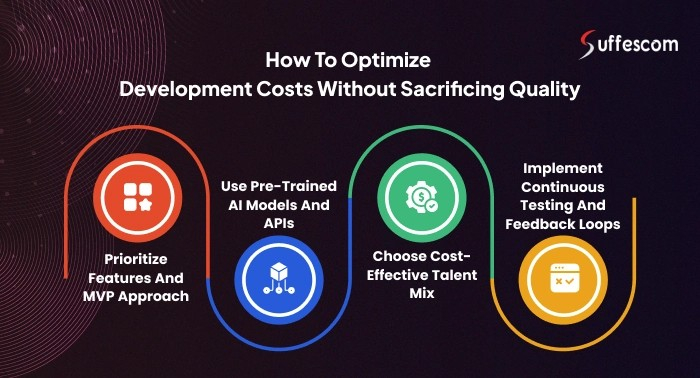
Developing an AI medical diagnosis app needs proper balance between budget and performance. Below are the cost-optimization techniques that help to maintain quality :
Prioritize Features and MVP Approach
Start with a Minimum Viable Product that gives emphasis on core diagnostic features. Prioritizing must-have features helps in faster time-to-market and lower initial investment. It considers the room for future repetition based on user and clinical feedback.
Use Pre-trained AI Models and APIs
Leveraging pre-trained models minimizes training time and resource consumption. It includes tools such as Hugging Face, Google Health AI, and Azure Cognitive Services. This can speed up development without compromising accuracy.
Choose Cost-Effective Talent Mix
Implement a blended team model being the integration of onshore leadership with offshore AI developers, UI/UX designers, and QA testers. The blended approach ensures the quality and compliance standards are met while hourly rates are maximized.
Implement Continuous Testing and Feedback Loops
Conducting automated testing, regular user feedback, and clinical validation is very crucial in the development process. Continuous testing minimizes rework, boosts model accuracy and ensures long-term cost efficiency.
Future Trends Affecting AI Medical App Development Costs
Several emerging trends are shaping the future of AI-driven medical app development. Understanding these changes is mandatory for successful budget planning:
Advances in Explainable AI (XAI)
As healthcare professionals increasingly require transparency in AI-driven decisions, Explainable AI is becoming the norm. Although it enhances trust and clinician adoption, incorporating XAI tools and visualisations can increase development time and expense.
Greater Regulatory Scrutiny and Expenses
Health and governments globally are making regulations stricter for AI. From clinical validation reporting to algorithm auditing, the cost of compliance is going up. Multi-market apps are now required to support various standards, which adds to their budgets.
Emergence of Edge AI in Healthcare
Edge computing is powering AI diagnosis at the device level, particularly remote monitoring and emergency response. Although it minimizes cloud reliance, creating lightweight, secure AI models for deployment on the edge requires specialized expertise and testing infrastructure.
Integration of Wearable and IoT Data
Apps that connect with fitness trackers, smartwatches, or medical sensors can offer better, real-time health insights. It helps to make sense of data, and keep it robust, which can increase development time and cost.
Conclusion
The total price of developing an AI medical diagnosis app depends on many variables. It encompasses the diagnostic feature complexity, the standards for clinical accuracy, data security implementations, and the requirement for real-time interconnectivity with health systems. Compliance with regulations, particularly with HIPAA, GDPR, and regional healthcare legislation, will impose an additional cost burden.
Budgeting Tips for AI Medical App Development
Start off with a well-defined MVP that addresses essential diagnostic workflows. Use pre-trained AI models in order to reduce cost and duration. Contracting out in nations like Eastern Europe or Southeast Asia will reduce the costs, but not at the expense of quality. Also, budget for recurring costs like upgrading the AI model, clinical validation, and security testing.
AI-based diagnosis tools are not experimental; it is changing the future of healthcare. But to build them cost-effectively, there's more than a brilliant idea needed. There is planning required, and the right development collaborator. Grab the company that strikes the balance between innovation and compliance, as well as cost-control. It will reap the most significant benefit in this rapidly developing area.
Hire Suffescom Today To Build Your Own AI Medical App
Our Ai app developers in USA are expert when it come to delivering top-notch Ai-powered app for healthcare industry, with experience of 12+ years in the industry and having a strong happy clientele of 800+ businesses.
Frequently Asked Questions (FAQs)
1. What is the average price to build an AI medical diagnosis app in 2025?
Development prices range from $15,000 to well over $50,000, and rely on the scope of the app, regulatory needs, features, and development region. Enterprise-level solutions with detailed diagnostics and integrations will obviously be higher.
2. How does AI influence the overall development price?
AI introduces both value and complexity. The costs increase from data preparation, model training, clinical validation, and the requirement for ongoing updates. Nevertheless, when utilized effectively, it combines with pre-trained models. AI can also make decision-making more efficient and lower long-term operational expenses.
3. What are the largest cost drivers in medical AI app development?
Key drivers are clinical-grade accuracy, health regulations compliance such as HIPAA, GDPR, etc. It includes secure infrastructure, quality training data, and cross-platform system integration. All these require specialized expertise and constant investment.
4. Which regions provide the cheapest AI medical app development services?
India, Eastern Europe, and Southeast Asia provide competitive prices with access to extremely talented developers. These markets possess increasing experience in health care technology and are able to produce quality work at almost half the price as the U.S. or Western Europe.
5. How significant is regulatory compliance to development cost?
Compliance is not a choice. It is considered a high-ticket cost element. Complying local and global healthcare regulations generally needs legal scrutiny, audits, and specialized compliance software. All this contributes to the initial and recurring expenditures.
6. Can low-code platforms be used for AI medical apps?
Low-code platforms have the ability to speed up development for admin dashboards. The core diagnostic features need custom development to meet performance, accuracy and security standards in medical environments.
7. What ongoing costs should I expect after launch?
Post-launch costs generally include AI model updates, cloud hosting and performance monitoring. Regular audits, new functionality integration, and bug fixes are also part of ongoing operational investment.
8. How can I guarantee the accuracy and safety of an AI medical app?
High-quality datasets, clinical validation, and ongoing testing are key. Involve healthcare professionals in development and adhere to strict QA procedures to guarantee the app is both safe and meets diagnostic standards.
9. What pricing models are common for AI app development projects?
Most companies provide Fixed-Price, Time & Materials, or Dedicated Team models. Agile or hybrid pricing is also widely used for AI apps because they are constantly changing. Your scope, timeline, and flexibility requirements decide the best choice.
10. How can startups reduce development costs without sacrificing quality?
Begin with a minimalist MVP, prioritize critical diagnostic use cases, and utilize existing frameworks or models. Offshore for development, but retain key decisions and compliance checks in-house or with known consultants.
11. What future technology trends will affect AI medical app costs?
Trends such as Explainable AI, Edge AI, and a more profound connection with wearables and IoT are defining the future direction of healthcare apps. Though they introduce new features, they also demand sophisticated tech stacks and more engineering effort, that cost more in the short term.

